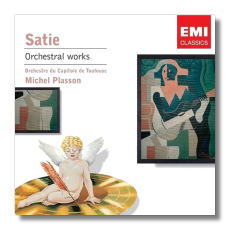
The Internet's Premier Classical Music Source
Related Links
- Latest Reviews
- More Reviews
-
By Composer
-
Collections
DVD & Blu-ray
Books
Concert Reviews
Articles/Interviews
Software
Audio
Search Amazon
Recommended Links
Site News
 CD Review
CD Review
Erik Satie

Orchestral Works
- En habit de cheval
- Gymnopédies #1 & 3 (orch. Debussy)
- Parade
- Relâche
- Gnossienne #3 (orch. Poulenc)
- La Belle excentrique
- Cinq Grimaces pour 'Le songe d'une nuit d'été' (arr Milhaud)
- Le Piccadilly
Orchestre du Capitole de Toulouse/Michel Plasson
EMI Classics 341444-2 DDD 65:28
This recent entry in EMI's budget-priced "Encore" series contains all of the orchestral works by Erik Satie that most collectors would want on their shelves. (Of course the Gymnopédies originally were works for the piano, but Debussy's sensitive orchestrations of the first and third have introduced them to the orchestral repertoire as well. Poulenc's less familiar orchestration of one of the Gnossiennes is no less effective.) Parade, a "realist ballet" based on an idea by Jean Cocteau, is written in his most public style. Sirens, gunshots, the sound of a typewriter, and other outré orchestral effects complement the music's tendency to turn on a dime. The ballet Relâche - the French word for "no show tonight" – is from the end of Satie's life. Its outrageousness is a little less obvious than that of Parade, but still, there's plenty in it to confuse and confound the bourgeoisie. It elevates inconsequentiality to an art form! In comparison, the remaining works are musical pencil-sketches of no great importance except for their entertainment value. (Most of them also exist in versions for piano or piano duet.)
Plasson's recording dates from 1988 and features excellent digital sound. His interpretations maintain a straight face, and they even have a coolness to them that is not foreign to Satie's musical personality. One can't imagine Satie breaking a sweat, so neither does Plasson. One of the best ways to ruin a joke is to laugh while telling it, and Plasson, to his credit, does not make this mistake. At the same time, these performances are so even-tempered that there's a risk of one piece seeming to flow into the next. Is this Satie's fault, or Plasson's? Whatever the case, this is another of those CDs that are most enjoyable when they aren't played all the way through.
As with other Encore releases, the booklet notes are minimal, although two pages are devoted to advertising other titles in the Encore series!
Copyright © 2006, Raymond Tuttle




















